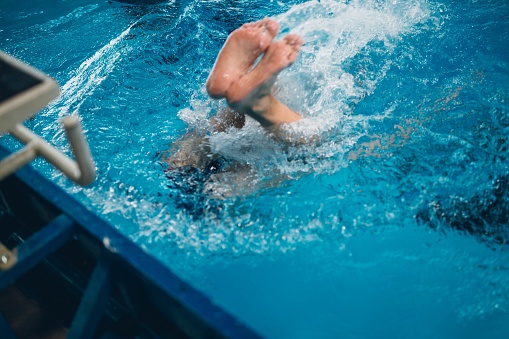To Flip Turn or Not to Flip turn
Throughout history there are great questions that have plagued mankind… To be or not to be? What is the meaning of life? Why do triathletes do flip turns (or tumble turns for those in other regions)?

The last one was included because at the beginning of each season there are those (like me) who always wonder why some triathletes use flip turns during training. I only ask these questions because:
- You can’t use them in the race – The triathlon swim occurs in rivers, lakes and beaches where there are no edges that would allow for flip turns. One of the main things I do as a triathlete is simulate race conditions as much as possible.
- Unnecessary effort – As a triathlete, energy conservation is key to a successful race. During the swim, bike and run, we strive to make our form as efficient as possible. We even buy expensive equipment to give us that extra edge in order to reduce drag. Flip turns seems like an area where extra energy is expended when it’s not needed.
And this is where I realized that this is a passionate topic for many people. Ordinarily athletes will provide a quick answer and continue training. However, when it comes to this question, there are those who will take the time to educate individuals like myself and explain that flip turns provide the following benefits:
- Many triathletes are wrong – you can use flip turns in triathlon – The triathlon season is long and it begins early in the year. In colder areas, the first races are held in pools. During these events, flip turns are permissible and help cut several minutes off a triathlete’s time.
- No resting – Flip turns are encouraged in almost all formal training environments because the wall is used as a micro rest area. Rather than push immediately off a wall, many (like myself), take an extra second to give my upper body a break and catch a quick breath. That quick break is not going to be possible during the open water swims.
- Keeps the flow and maintains momentum – After a while, the flip turn becomes a natural part of the session. Long swim sessions become one continuous unit rather than chunks of 25-meter sessions. Eventually, a natural rhythm develops and not doing flip turns becomes weird.
- Improved lung capacity – Using flip turns prevents swimmers from taking that quick break and forces a continuous flow of activity that results in constant demand for air. This puts the body in a slight state of hypoxia which helps develop lung capacity and improve the body’s ability to utilize oxygen.
- It’s fast – The average swimmer loses a few seconds each time the wall is touched because of the pause and quick breath. Those brief instances may not seem much, but over the course of a 500 meters swim those seconds add up to minutes.
- It helps you get faster – As mentioned above, the flip turn makes the body work harder and in swimming intensity matters. The flip turn simulates a state in which the body is learning to work under a higher stress load and adapt. This adaptation allows your body to swim faster with less effort.
- Pride in their ability – Those who have a background in swimming take pride in their ability to swim efficiently and produce fast lap times while making it look effortless. Swimming is about technique and part of that is the flip turn.
- It’s cool – In many cases, people do flip turns simply because they can. Also, it looks cool and it frustrates those who can’t.


